Everything You Need to Know About Pet Finches
If you're interested in a small pet bird that isn't loud, doesn't take up much space, will bond with you, and learn to come to its name, consider a finch.
They're available in hundreds of varieties, with many colorations, patterns, and personalities.
We turned to avian and exotic pet veterinarian Dr. Laurie Hess, DVM, Dipl ABVP (Avian), the owner and medical director at the Veterinary Center for Birds & Exotics in Bedford Hills, New York, to learn more about pet finches. She also serves as the editor-in-chief for the Merck Veterinary Manual and has a fondness for owl finches that resemble tiny versions of their namesake.
She says pet finches truly are like potato chips. You can't have just one!
"In fact, you should always have two together because they're very social," Hess educated. "You start with two, and you want more and more and more because it's fun, and you end up with a whole cage full of finches."
Hess recommends chatting with your local avian veterinarian about which species of finch work well as aviary mates. And, although it's fine to keep males and females together, it's best to stick with one sex to avoid unwanted breeding.
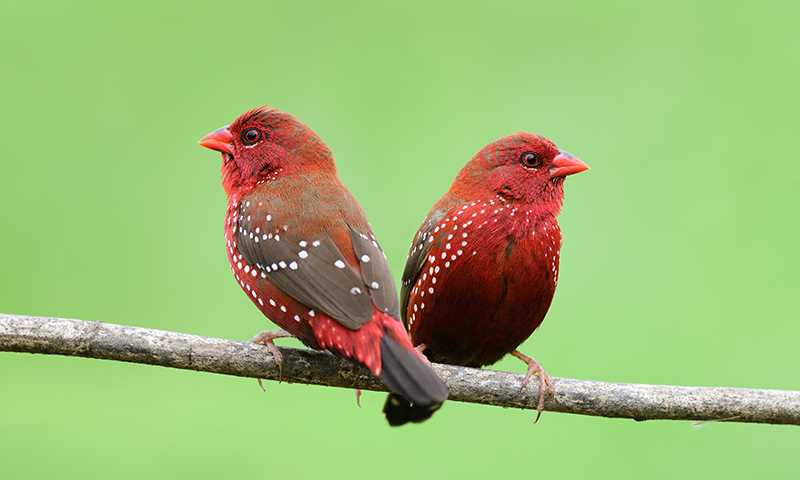
Two strawberry finches perched on a branch.
What Colors Are Pet Finches?
There are hundreds of varieties of pet finches — from the zebra, society, strawberry, and spice to the Gouldian, owl, house, and so many others — each with its own colors and patterns. You can truly find an option you'll find attractive.
One of the remarkable varieties kept as pets includes the Gouldian finch, a native of Australia. Adult birds look like a painter's canvas, with bold blocks of green, yellow, purple, blue, and red.
The attractive mix of barring and polka dots on the orange-beaked zebra finch woos many bird lovers. The males also have bold orange cheeks.
"Another one of my favorites is the strawberry finch. They have the red (body) with little strawberry markings," Hess added. Males have small white speckles that look much like seeds dotting the surface of a berry.
What Sounds Do Pet Finches Make?
With their small statures come small voices. Finches share gentle, quiet sounds of peeping, trilling, and beeping, as well as some melodic singing.
Hess says people living in apartments, condos with shared walls, or with family members with sensitivities to noise make ideal finch parents.
"They don't make a ton of noise. They make some, but they're not like the screaming loud conures or other birds, that you really have to have a lot of space and tolerance for," Hess shared.
She says finches will make louder distress sounds if necessary. However, they usually vocalize in calm ways while foraging for food, trying to attract a mate, when they are greeting the morning sunshine, or when it's evening and they are ready to say goodnight.
"There's a whole language that we don't understand, but certainly the finches understand. People studying finches have noticed that it's not all the same and that there are different sequences of sounds they make when they're trying to communicate," Hess added.
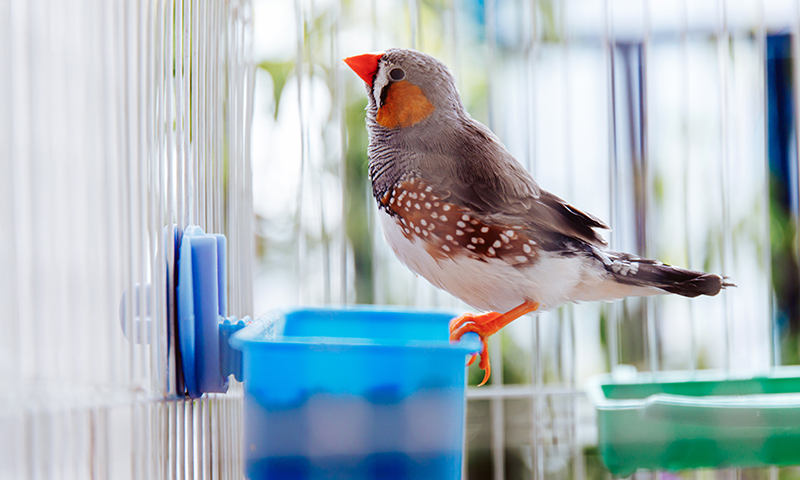
Zebra finch perched on food bowl in aviary.
How Big Are Pet Finches?
Pet finches weigh in at 10 to 12 grams each and measure approximately four to six inches in length, from head to tail tip. As a comparison, parakeets (also known as budgies) usually measure about 30 grams, about three times the size of a petite finch.
"They fit literally in the palm of your hand," Hess laughed. "They have a lot of personality, even if they're very, very small."
When choosing housing, Hess says a pair of finches can live comfortably in an aviary measuring 24" long by 24" deep by 18" tall. This gives them space to flutter around. Of course, a larger space always creates a more enjoyable home for your pets, so go bigger if possible when selecting an aviary.
"One thing you have to think about is bar spacing," she educated. "Finches have little teeny heads, legs, and wings. You don't want them to get stuck. So ideally, choose a quarter-inch to maybe half an inch maximum aviary bar spacing."
She says if you've adopted a juvenile finch or have a fondness for a super teeny variety of finch, choose an aviary with no more than a quarter-inch spacing between the bars to keep your pets safe. It's also a good idea to consider a locking aviary for more security from curious children in the home or tricky, Houdini-like birds.
And when it comes to shape, the classic round habitat isn't ideal. It doesn't give your pet anywhere to cling or hide, which becomes stressful psychologically and physically for a bird. Finches prefer square or rectangular habitats so they can use the corners.
Hess says it's best to keep the finch aviary away from the kitchen, where non-stick pans, air fryers, propane, and appliances that emit odorless, colorless gases are often used. Finches have sensitive respiratory tracts. If they breathe in these emissions, they can get sick and die.
When cooking, Hess likes to crack a window or door open just a bit to better circulate the air and keep potential gases away from her feathered companions.
Finally, birds need access to UV light. You can place a special avian UV lamp near the aviary to help your pet make vitamin D in their skin. Hess says vitamin D assists in calcium absorption in the body, and becomes particularly important for egg-laying female finches. Placing the pet near a sunny window isn't enough since the glass filters out the nourishing UV wavelengths.
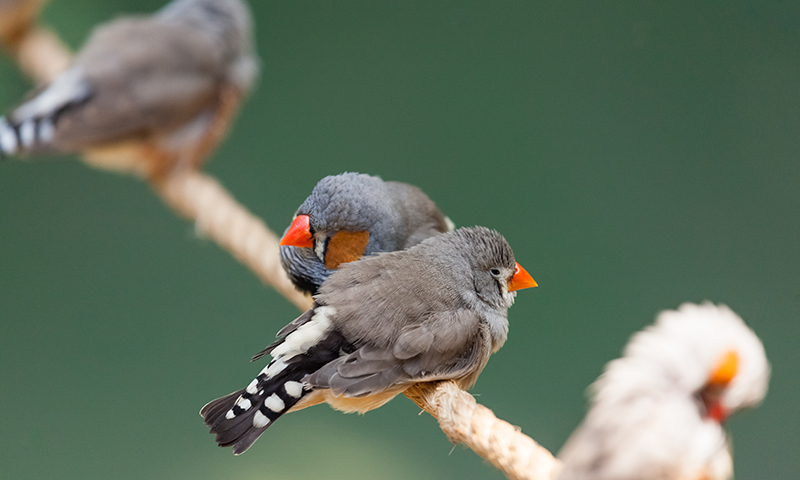
Zebra finches sitting on rope swing.
Do Pet Finches Like Toys?
Yes! Finches love toys in their aviary. Since finches have tiny, soft bills, they don't rip and shred like parrots with larger bills. Instead, offer them engaging toys such as swings to sway on. Or, they can benefit from a variety of perches to hop among. Finches also love to climb, so things like ladders and ropes give them options to stretch their legs.
Hess says finches also enjoy foraging toys that have food tucked inside. She says a little balsa wood ball with holes in it, stuffed with pieces of minced vegetables or fruits, allows for both play and foraging.
Finches also love tiny little bells to tap and small dishes of water for an occasional bath to cleanse their skin and feathers.
"Unfortunately, there are a lot of bird toys out there with metal on them that have lead in them. So if you're going to get them, make sure you buy them in the US," Hess explained. She says toys built with lead, copper, or nickel can become toxic to pet birds.
With finches, you may want to avoid offering a mirror toy. This can encourage territorial issues and reproduction (which can cause health issues such as egg binding if you're not planning or wanting baby finches).
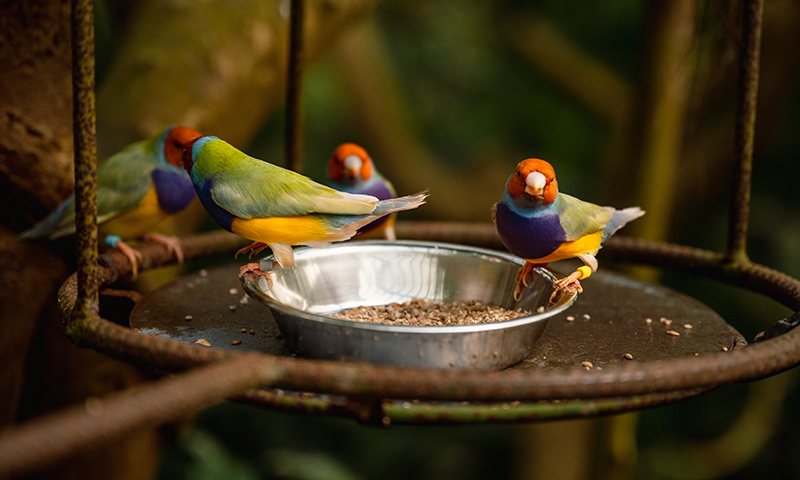
Gouldian finches perched on food bowl.
What Do I Feed My Pet Finches?
Hess says pelleted bird food should make up about two-thirds of the pet finch diet. An all-seed diet can't accurately replicate what a finch would eat in the wild close enough, which may lead to nutritional deficiencies and reduce your pet's longevity. A pet finch lives approximately 4 to 6 years, with some varieties making it up to 17 years.
In the wild, finches do eat seeds, but they also feast on insects, seasonal berries, flowers, and more. A colorful mix of pellets mimics these naturally foraged, or scavenged, food items.
"Birds see in color. They choose their food, in large part by color, because they can detect the ripeness of the fruit or the maturity of the seed in the wild," Hess shared. "We don't eat all brown food, right?"
In addition to the colorful pellets, she says finches do need some fats in their diet. This can come from seeds. Fats help with hormone production to encourage males to sing and females to lay eggs. Hess says seeds should make up no more than 30% of your pet finch's diet.
Try some of these pelleted and seed diets with your pet finch:
-
Kaytee Fiesta Canary & Finch Food: This blend features dried fruits, vegetables, grains, and seeds with a variety of shapes for mental stimulation. The nutrition supports digestive, brain, skin, and feather health for your pet finch.
-
Kaytee Forti-Diet Pro Health Canary & Finch Food: The natural antioxidants, probiotics, and prebiotics in this mix support digestive, skin, and feather health. Your finch will love the combination of pellets and seeds.
-
Kaytee Supreme Canary & Finch Food: Seeds, pellets, and grains make up this tasty finch food mix. It offers the necessary protein and fiber needed to keep your pet finch happy and healthy.
-
Kaytee Songbird Treat for Canary & Finch: As you spend time with your pet finch, you may want to offer an occasional treat to help boost his musical skills. The delicious niger, flax, canola, sesame, red millet, yellow millet, and anise seeds found in this treat will please your bird.
Finally, top off your pet's meals with some vegetables rich in vitamin A to promote a healthy respiratory tract and feather growth. Consider offering shredded fresh, raw carrots, squash, yellow peppers, and dark leafy greens, such as kale and spinach. A little fruit is okay too, in moderation. Try soft pieces of strawberry, raspberry, kiwi, or banana.
Hess says finches need fresh water and pellets available in dishes in the aviary at all times. Then, offer seeds occasionally and fresh produce for a limited amount of time in separate dishes. This makes it easy to remove them when the produce begins to wilt and seed feeding time is over.
"You don't want to leave vegetables in the habitat all the time because they do go bad, and they can lead to infection. So I encourage people to offer those things at a social time," she added. Give fresh produce when you're talking with your pet, working on training, or doing other bonding activities.
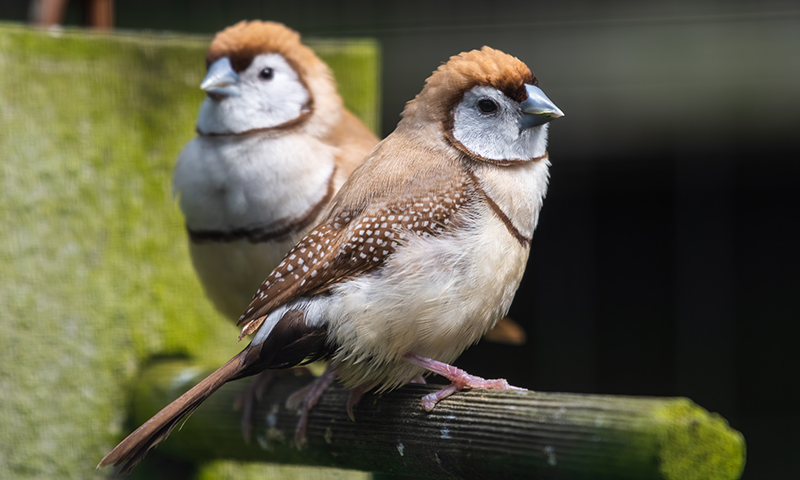
Two double-barred (aka owl) finches sitting on a perch.
How Can I Bond with My Pet Finches?
Sociable finches look forward to spending time engaging with you.
When you initially bring your pet home, he may become suspicious of his new surroundings and try to bite. Avoid sudden movements and let the bird familiarize himself with his new home. Create a daily routine that allows you and your bird to bond over familiar tasks, including refilling fresh water, offering new food, and tidying up the aviary.
Then start talking with your bird through the bars of the habitat. Hess says finches do indeed recognize their owner's face and voice. Your bird will start to associate you with pleasurable things, such as singing to them, offering food, and giving attention.
"Watching the interactions between finches and just listening to their calls, I think it's a lot of fun," Hess added. "They are more of a 'watch' than 'handle' type of bird, but that doesn't mean they can't get to know you and respond to your voice and your sight."
If you're parenting a handful of vocal male finches, you can bond by encouraging them to sing their beautiful songs. Do this by playing a YouTube video of a male finch singing to listen to together or by separating your finches (if you have two aviaries) and letting them call to one another from different rooms.
Note: Both male and female finches can sing. However, males dominate in this area. Females sing shorter songs (and less often) than males.
Although most people don't hold their finches, with patience, you can carefully train them to hop on a perch or your finger and spend time outside of the aviary with you after getting acclimated to their new home (a few weeks). However, finches fly, so precautions such as shutting curtains, covering mirrors, closing doors and windows, turning off ceiling fans, and removing other pets from the room, help keep the bird safe.
Small, Adorable Finches Make Great Pets
If you're hoping to bring some of the magic of the outdoors inside, having pet finches will do just that. You can admire these tiny birds and how they interact with one another, forage for food, sing, and watch you move around their aviary.
"They can bond to you, and just be such incredible pets," Hess said.
Learn more about taking care of your feathered friend in General Care for Pet Birds.
